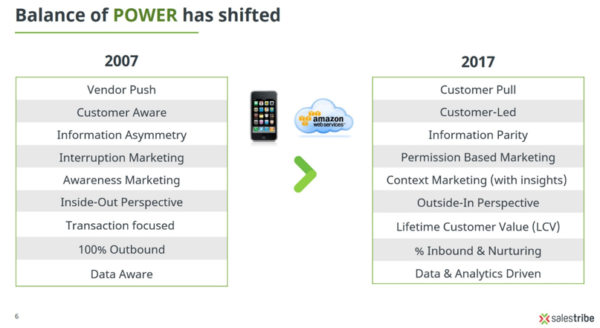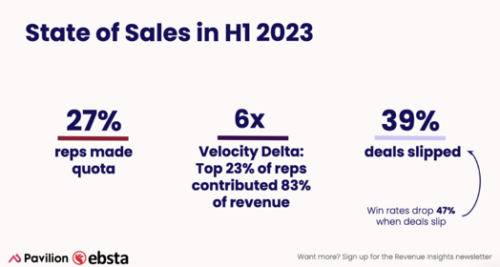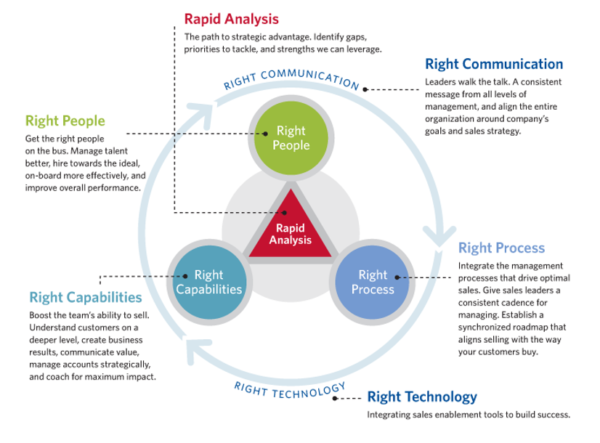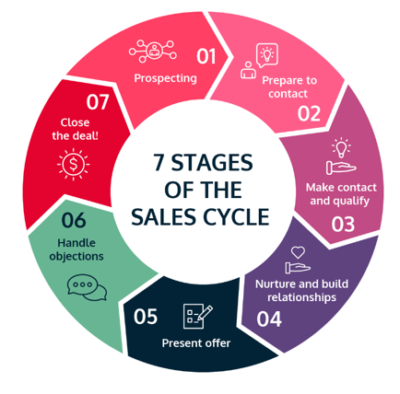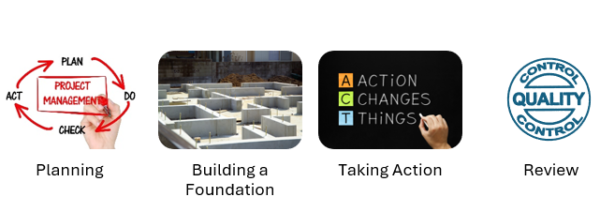Optimizing Sales

The Appleton Greene Corporate Training Program (CTP) for Optimizing Sales is provided by Mr. Monroe Certified Learning Provider (CLP). Program Specifications: Monthly cost USD$2,500.00; Monthly Workshops 6 hours; Monthly Support 4 hours; Program Duration 12 months; Program orders subject to ongoing availability.

Personal Profile
Mr. Monroe is a Certified Learning Provider (CLP) at Appleton Greene. He has spent his career in High Tech sales and sales leadership positions. Hired straight out of University by AT&T, David was one of the first 100 employees hired by AT&T outside of the US. David then transitioned to software sales and was a founding member of the Nixdorf Optical Document Management team in Toronto, Canada, securing the first sales with the Canadian Federal Government and a leading Property and Casualty Insurance company prior to the acquisition of Nixdorf by Siemens. Having had considerable sales success in the Telecommunications and Imaging industries, David was recruited to join a leading Canadian Executive Recruitment firm where he specialized in placing Sales and Sales Leadership roles before returning to the Software industry where he has spent most of his career.
With a proven track record of sales success early in his career, Mr. Monroe transitioned to Sales Leadership and has spent the last 25+ years of his career building new sales teams or fixing broken sales organizations. With a passion for sales and building/fixing teams, David has been hired by the same CEO’s on multiple occasions which is a testament to his ability to deliver results in the most challenging scenarios.
Mr. Monroe’s proficiency in sales organization optimization has played a crucial role in the financial success of both start-up and mid-market high tech companies. David’s common-sense approach to sales success is rooted in the recognition that your sales team members are your most valuable commodity. Creating an environment that clearly lays out expectations, removes obstacles and marries the best sales strategies with new technological advancements has made his approach to sales optimization as critical today as it has been throughout his career.
With a strong focus on delivering consistent and reliable sales results, Mr. Monroe’s proven strategies create trust with other functional areas of an organization, the C-suite Executive Team and Board of Directors.
Mr. Monroe, as VP Sales, led Reward & Recognition start-up Cooleaf to #1,637 on the Fast 5000 privately held companies list in 2021. Cooleaf has since been acquired by ITA Group. As EVP & CRO at Awee (Cybersecurity Education start-up), he has been quoted in numerous publications in 2024 including LA Weekly, USA Today and MSN. Working throughout his career in North America, the Caribbean, Southeast Asia, Europe and the Middle East, Mr. Monroe’s approach has delivered consistent results around the world.
Recently, Mr. Monroe founded a boutique management consulting firm to bring his unique blend of sales experience, insights and perspective to a broader audience.
Education-wise, Mr. Monroe holds a Bachelor of Social Science from the University of Western Ontario.
With a solid foundation of experience, knowledge, and a results-driven approach, Mr. Monroe is well-equipped to contribute to the success of any sales organization.
To request further information about Mr. Monroe through Appleton Greene, please Click Here.
(CLP) Programs
Appleton Greene corporate training programs are all process-driven. They are used as vehicles to implement tangible business processes within clients’ organizations, together with training, support and facilitation during the use of these processes. Corporate training programs are therefore implemented over a sustainable period of time, that is to say, between 1 year (incorporating 12 monthly workshops), and 4 years (incorporating 48 monthly workshops). Your program information guide will specify how long each program takes to complete. Each monthly workshop takes 6 hours to implement and can be undertaken either on the client’s premises, an Appleton Greene serviced office, or online via the internet. This enables clients to implement each part of their business process, before moving onto the next stage of the program and enables employees to plan their study time around their current work commitments. The result is far greater program benefit, over a more sustainable period of time and a significantly improved return on investment.
Appleton Greene uses standard and bespoke corporate training programs as vessels to transfer business process improvement knowledge into the heart of our clients’ organizations. Each individual program focuses upon the implementation of a specific business process, which enables clients to easily quantify their return on investment. There are hundreds of established Appleton Greene corporate training products now available to clients within customer services, e-business, finance, globalization, human resources, information technology, legal, management, marketing and production. It does not matter whether a client’s employees are located within one office, or an unlimited number of international offices, we can still bring them together to learn and implement specific business processes collectively. Our approach to global localization enables us to provide clients with a truly international service with that all important personal touch. Appleton Greene corporate training programs can be provided virtually or locally and they are all unique in that they individually focus upon a specific business function. All (CLP) programs are implemented over a sustainable period of time, usually between 1-4 years, incorporating 12-48 monthly workshops and professional support is consistently provided during this time by qualified learning providers and where appropriate, by Accredited Consultants.
Executive summary
Optimizing Sales
Addressing and reviewing revenue processes to Optimize Sales is a valuable exercise regardless of the current state of sales results in your organization.
Over the last 15+ years, the sales profession has undergone its most dramatic changes in decades. The emergence of new technologies in Customer Relationship Management (CRM) and Sales Performance Management (SPM) have provided automated tools to help streamline sales processes and reduce errors in commission payments. These tools have also made more information than ever available at the fingertips of both individual contributor and sales leadership roles. The Internet has changed the power relationship in B2B sales by transferring the position of strength from the solution provider to the client/prospect.
Some of these changes have driven significant improvements in the ability to track progress against sales goals and objectives while ensuring all stakeholders have access to critical information. The advent of ever more detailed and complex CRM solutions and SPM solutions have automated many of the manual tasks associated with B2B sales.
Traditionally, commodity sales (photocopiers, life insurance, etc.) were viewed as very transactional and #’s driven. In this model salespeople were incentivized to make as many calls as possible to drive increases in sales. B2B sales like computer systems and software were viewed as more complex and more relationship oriented. The goal was to build a relationship that ensured the salesperson had the opportunity to learn about the client’s business while also providing the client with an ability to learn about different solutions in the marketplace.
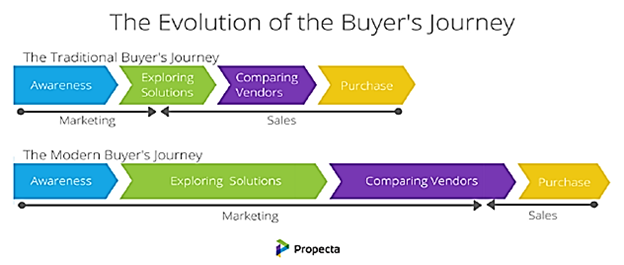
The traditional relationship selling model was centered around, lunches, dinners, events and golf to “get to know each other” and determine if there was a level of trust to work together. This worked well in a world where prospects needed to meet with solution providers to understand their solutions and how they may meet their needs. In this historical environment, purchasing decisions were made by individuals and/or small teams that you worked closely with to secure their business.
It was difficult for prospects to learn about potential solutions unless they went to Trade Shows or engaged in exploratory conversations with potential suppliers before the advent of the Internet. In this scenario salespeople had a captive audience of organizations and individuals that wanted to meet with them. Senior Executives even answered their phone, or you could connect with an Executive Assistant and build rapport before they would let you speak to their boss.
Salespeople would target their organization’s Ideal Client Profile (ICP) prospects and then reach out to key decision makers to connect and set up a Discovery Meeting.

Salespeople had great autonomy over their schedules. With no CRM to fill out they held all the knowledge about the client/prospect and their specific needs in their files. They would share it with the support team and deliver a typed-up forecast or print off a spreadsheet with deal details, $ amounts and dates to be rolled up into a team, region, division sales funnel and forecast.
Salespeople had a sense of control over their schedule and many gravitated to the role because of the ability to “be on the road” and responsible for your own schedule and ultimately your sales results.
A strict and inflexible use of new tools and associated data has in some instances reduced the oversight of sales to the equivalent of a mathematical formula. This approach removes the human element and accentuates the belief that sales success is purely a #’s game. The belief is that by doing more cold email outreach, more cold calling, etc., you will be able to deliver ever greater pipeline opportunities and ultimately increase sales. Although these approaches may have delivered incremental gains to early adopters, the market has tuned out to excessive “spam” type outreach by B2B sales organizations.
Ultimately, sales success in B2B sales is about weaving new technologies and strategies into a foundation of personalization that delivers impact. The best salespeople spend more time thinking critically and strategically to differentiate themselves and their organization they represent. It is about quality over quantity.
Although many sales leaders have relied heavily on their dashboards to understand their business, the very best insights are captured when working in the field shoulder to shoulder with team members. There is no technology that can replace the value of meeting people in person to build rapport and understand how each may assist each other to mutual benefit. Zoom meetings were a necessary requirement when navigating the Pandemic and allowed much of the business world to continue without the need for in person meeting. Video conferencing can still play an important role in the future of B2B sales but only when supported with strong personal relationships and working partnerships between solution suppliers, partners and potential clients.
Sales compensation has become ever more complicated. The chatter amongst salespeople is that they often cannot figure out how much they should get paid when closing a transaction. We have all seen the devastating negative impact on a sales organization when the goal posts for sales success are moved and the resulting broken trust between the organization and their sales team. Trust takes a long time to build but can be broken instantly and is extremely difficult to repair.
The best sales compensation plans allow a sales rep to determine how much they would make after leaving a good sales call. Salespeople are coin operated, and income is a significant motivator. If you are not using this lever to drive engagement and focus you are not using compensation to your benefit as an organization. The concept that “salespeople make too much money” is like a cancer when it creeps into an organization. It can spread quickly and undermine how other operational areas view sales, and ultimately drive down morale and motivation on the sales team.
Further complicating the sales landscape today is that decisions are now often driven by an ever-increasing group of people assigned to explore solutions and make recommendations. Purchasing groups are playing a much more active and assertive role in the procurement process making the selling process ever more complex.
 The future of B2B sales will need to continue to evolve for those who want to excel moving forward. A hybrid model is emerging, taking the best of both the new technologies that are available but also not walking away from historical aspects of sales strategy that have been proven to deliver results consistently. Unfortunately, many sales organizations have taken their eye off the ball when it comes to sales fundamentals. All the focus has been on entering vast amounts of data by front line salespeople, managing dashboards by sales management to make sense of the volume of information collected and generating enormous spam like sales outreach campaigns.
The future of B2B sales will need to continue to evolve for those who want to excel moving forward. A hybrid model is emerging, taking the best of both the new technologies that are available but also not walking away from historical aspects of sales strategy that have been proven to deliver results consistently. Unfortunately, many sales organizations have taken their eye off the ball when it comes to sales fundamentals. All the focus has been on entering vast amounts of data by front line salespeople, managing dashboards by sales management to make sense of the volume of information collected and generating enormous spam like sales outreach campaigns.

Despite all the new technologies available to assist sales organizations we continue to see a steep decline in sales success.
A Salesforce study in November 2023 found that “only 28% of sales professionals expected to hit quota in 2023.”
The Salesforce study is backed up by independent research by RepVue that found that “tech sales professionals making quota declined from 53% in Q1 2022 to 42.8% in Q3 2023.”
There is no silver bullet that will reverse this trend. An understanding of the issues undermining the foundation of a successful sales organization is a great place to start. Ask yourself the following questions.
The place to start is to better understand if you are hiring the right people into the right sales roles and then are you onboarding them effectively? Without hiring the right people and then providing all the internal contacts, tools and resources to get the job done well, you are setting your organization up to fail. We will discuss how to identify the right profile(s) to hire and then how to bring them onboard in a way that sets them up for success.
Do you find that sales leadership is in the office more than in the field? Have they defaulted to trying to run their sales organization from their dashboards? This is a common mistake made and we will talk about the benefits of sales leadership getting closer to clients and prospects in the field to really understand what is going on and build relationships that will deliver impact moving forward.
Is your compensation plan difficult to understand for salespeople? Can they estimate what they might make on a deal after a great sales call? The compensation plan needs to be aligned with overall corporate goals and objectives to ensure it incentivizes the right behaviors. We will discuss what that might mean for your organization.
What % of your sales organization is achieving quota annually and is this number going up or down. There are many reasons for a falling % of salespeople achieving quota annually and we will review what can be done to reverse this trend.
Does your organization tolerate bad sales behavior from those that consistently achieve the desired revenue goals? If this is the case it is often a short-sighted approach that can lead to dissention on the team, poor team chemistry and ultimately good people leaving the organization.
What role does the ICP play in your organization’s prospecting efforts? Do salespeople play an active prospecting role, taking a personalized approach to augment more broad “shotgun” style prospecting by marketing? We will review the importance of your prospecting efforts revolving around your unique ICP and the critical role that B2B salespeople need to execute in this process.
Is your forecast unreliable and susceptible to frequent delays or slippage on key deals? Does everybody speak the same forecasting language? Deal delays and slippage are often the case when there is no common language utilized by the organization to define the forecasting model so there is no room for interpretation. When a common language approach is taken, it becomes abundantly clear to everyone involved what a “Commit” deal means or what is an “Upside” deal and what is required to move a deal through each stage in the sales funnel effectively. Ultimately the goal is to deliver a sales forecast that can be trusted by senior leadership and is sustainable/repeatable for the long term.
Often when sales are stagnant or falling, the first reaction is to micromanage the sales team. We will discuss how this is an “unforced error” that can be avoided by better understanding both what is causing the challenging sales results and what makes your salespeople “tick” and what truly motivates them.
Does your team lack critical competitive intelligence? If so, they may be seen as a “me too” by prospects that cannot adequately differentiate your solution vis-à-vis the competition. We will talk about the importance of having a firm grasp of your differences in the market and why they are important to your clients and prospects.
How does your team think about responding to an RFP? Do they see it as a potential waste of time if it is unsolicited? We will cover the way to respond to each RFP with confidence and make the right decision in real time about responding or walking away.
The future of succesful sales organizations will lie in the utilization of the best of the past (personalization, differentiation, working together in the field) and the best of the current/future technology landscape. Organizations who embrace this model will find that a personal touch connected to data and facts will prove to be a powerful combination.
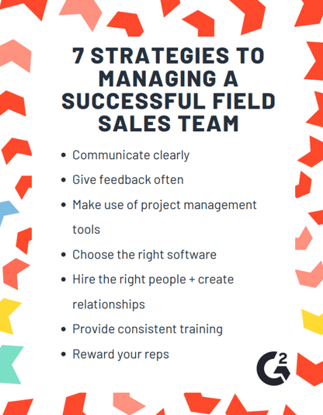
Utilizing the power of new solutions simply to create ever more complex and confusing compensation plans and drive vast amounts of mindless “spam” like outreach seems to be miss the point. The core of successful B2B sales is strategic and creative thinking coupled with strong personal relationships. Organizations need to resist the belief that automation and Artificial Intelligence (AI) can fully replace what people need to do. Real incremental improvements will come from marrying personal interaction and relationships with powerful technologies available to us that will lead to compelling differentiation.
Compensation plans must engage salespeople and motivate them to deliver the objectives set out by the organization. Understanding how and when you get paid is foundational and critical to success. When salespeople can determine how much they will make and they know that they are part of a team that can deliver results, magic happens.
Sales leaders, like the best coaches in sports need to be closely connected to their teams. They need to share aspirational goals and objectives with team members. Respect and collaboration are a two-way street. Sales leaders need to be available in the field and provide mentorship and coaching in real time. If you are constantly working from your office and relying on dashboards to inform your decisions, you are not in close proximity to where the critical insights and perspectives reside.
Technology like CRM, SPM and AI will all play a critical role in sales success moving forward. AI can play a role in Content Generation, Data Analysis and the automation of various tasks. Risks will need to be understood and managed. How will you protect personal information from use/abuse, AI can lack empathy and can resort to false information when not able to identify a fact-based response. If human oversight and management is not a critical piece of the equation the chance of significant errors is great.
The underlying foundation of sales in the B2B environment is still very much a people driven business. This both applies to relationships and collaboration within your own organization to meet client needs as well as when you are working with potential prospects. Finding the sweet spot where technology and the human elements connect will drive a winning sales strategy moving forward.
The growing complexity of the sales process with teams assessing solutions, procurement playing a critical role and organizations doing much of their research before speaking with suppliers means that the human element is even more critical than ever. Salespeople must be steeped in the fundamentals that will drive success. Organizations need to hire the very best, onboard them well, ensure that they have the resources to meet clients “where they are” and their sales leaders need to be there with them collaborating and working in the field together. Central to all of this is a simple and easy to digest compensation model that drives the behaviours that will lead to success!
Although the oversight that comes with technological advances will never go away, smart sales leaders will develop and foster an environment of mutual trust and respect. You have hired these team members because they know what they are doing, fit within your team culture and have a track record of success. Sales leaders should give them the opportunity to do their job with the nuance that works for them and delivers the results that they are looking for. Don’t micromanage them and if they have accurately input the data to the CRM that you are looking for, then show them the requisite respect and read the CRM and don’t them ask questions you could find yourself!
Our objective is to implement sales processes that will provide sales leaders in your organization with high-level skills, tools, and support, so they can deliver reliable and sustainable sales results. The approach is to take a step back, understand what you are doing and why, providing sales leaders with needed perspective and knowledge to both focus on the numbers but the underlying human foundation of sales success.
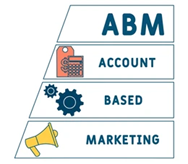
When artificial intelligence is applied into ABM tactics, it dramatically increases their effectiveness. AI’s ability to analyze massive amounts of data enables more in-depth insights on buyer behavior, preferences, and pain areas. Businesses can use machine learning algorithms to anticipate which accounts are most likely to convert, uncover upsell or cross-sell opportunities, and optimize content distribution based on real-time interactions. This data-driven strategy enables sales and marketing teams to prioritize high-potential prospects, ensuring that resources are allocated efficiently and effectively.

In the context of complicated B2B sales, where purchasing decisions frequently include several stakeholders and protracted sales cycles, the marriage of ABM with AI is transformative. It enables firms to traverse complex purchasing processes by ensuring a thorough awareness of each account’s specific needs, issues, and decision-making process. As a result, ABM and AI not only boost sales results, but also improve the strategic alignment of marketing and sales teams, resulting in long-term growth and client loyalty in competitive B2B markets.
Curriculum
Optimizing Sales – Part 1- Year 1
- Part 1 Month 1 Challenges Identified
- Part 1 Month 2 Common Mistakes
- Part 1 Month 3 Building Strategy
- Part 1 Month 4 Maintain Trust
- Part 1 Month 5 Compensation Plans
- Part 1 Month 6 Territory Reviews
- Part 1 Month 7 Forecasting Model
- Part 1 Month 8 RFP Strategy
- Part 1 Month 9 Prospecting Preparation
- Part 1 Month 10 Hiring/Onboarding
- Part 1 Month 11 Deal(s) Slipping
- Part 1 Month 12 ABM and AI
Program Objectives
The following list represents the Key Program Objectives (KPO) for the Appleton Greene Optimizing Sales corporate training program.
Optimizing Sales – Part 1- Year 1
- Part 1 Month 1 Challenges Identified – The objective of this workshop is to identify key challenges facing sales organizations today. A selection of identified challenges will be addressed, and the group will be asked to provide feedback on the topics covered and to add topics for group discussion that they want to bring to the group. This exercise will help to build a foundation for understanding the complexity of the sales process landscape as it exists today. It is understood that not all topics will apply to all organizations and by soliciting feedback and input from the group we are looking to expand our understanding and bring a collective strategy to address challenges identified by the group. Key areas to be covered include forecasting to ensure that it is seen as reliable, and everyone is speaking the same language. Onboarding needs to be a critical element of sustainable sales success that sets every new hire up for long term sales goal achievement. Everyone on the sales team must understand the foundation of daily sales activity that will lead to ongoing sales performance that meets or exceeds expectations. We will explore what your ICP looks like and ensure that it becomes the focal point of prospecting efforts. We will discuss the critical importance of preparing ahead of time for each prospect/client interaction. Never is this more important than before a first meeting. How do you handle unsolicited and wired RFP’s so that sales have a game plan and strategy to execute that gives them confidence about how and why they are investing their time in this activity. When a deal starts to go sideways or is delayed what do you do? We will identify a strategy to engage with a prospect on a high probability deal that looks to be slipping in the forecast to give us our best shot at getting the deal back on track.
- Part 1 Month 2 Common Mistakes – The objective of this workshop is to identify common mistakes that sales organizations make when starting to address simmering challenges that have been identified. The group will be canvassed to understand the specific challenges that they see in their organization, and we will explore as a group how those challenges were identified and what is their current strategy to address them. We will also work on an understanding of the real impact of the common mistakes that are made. A “knee jerk” reaction when confronting initial sales challenges is to micromanage the individuals or teams that are experiencing the challenges. This can suck the life and joy out of a sales organization without addressing the underlying issues. This will often simply result in people leaving and will not address the real underlying reasons for the reduction in sales performance. Mindless high-volume prospecting can also become a serious distraction. The most important skill in B2B sales is critical thinking and the development of strategy. When you remove or diminish the personal, human elements you become a “me too” that minimizes your differentiation. Your biggest and most important differentiator you possess is your people, closely followed by your unique solution. With sales leader turnover at an all-time high, average tenure for sales leaders currently is 16-18 months, leaders can quickly find themselves in a them vs. us scenario with their own sales team. The pressure sales leaders are under can result in them taking a more adversarial approach with their team and reviews start to feel like interrogations vs. a team working on a collaborative approach to win business! Lastly, organizations will often resort to “throwing people at the problem” or raising quotas. Without getting to the root cause of the stagnant or falling sales, adding more quota carrying salespeople or raising quotas to try and solve the problem will only make it worse. Ultimately, organizations experiencing falling sales and resulting falling incomes create a perfect storm of negative messaging. When this combination of bad news hits the street, it will be more difficult to recruit the right kind of sales talent for your team/organization. It becomes a vicious cycle that will quickly spiral and become very difficult to turn around.
- Part 1 Month 3 Building Strategy – The objective of this workshop is to start to bridge the gap from problem identification to strategic action to address identified concerns. Participants will be asked to share stories from their organization around addressing sales challenges that have worked for them and those that have created additional concerns. It is critical to understand the nuances of your organization and where it might be in developing strategy to address sales-related problems. Has this been a focus in the past and if so, what were the results? With a better understanding of the past, we can inform our decisions to drive a better future outcome. Auditing sales strategies and operations is a great first step to developing a comprehensive approach to move your sales organization forward. Easy places to start including building an ICP for your organization. When you have this built you can then identify the salespeople who have long-term sustainable success in your organization. With this additional knowledge you can then develop a comprehensive profile for each sales resource required on your team. The combination of an ICP with well-articulated sales role profiles builds a strong starting point for long-term sales success. Identifying ways to simplify your compensation is critical. By doing so, you can ensure that your comp plan will be closely aligned with corporate objectives. Salespeople will understand how and why they are compensated fairly when achieving the sales results that everyone is looking for. Success is tied to leaving no area for doubt or interpretation around being paid fairly when sales goals are achieved! Focusing on your forecasting model and creating a common language that everyone uses and intimately understands will be critical to creating a sustainable approach to forecasting that can be relied on by senior management. Part of this process will be to simplify the stages in the sales funnel while also providing the granularity necessary within each stage to allow a deal to develop and progress through the funnel process. Having a daily sales activity model where everyone understands the ongoing importance of prospecting for new opportunities, nurturing early and mid-stage deals in the funnel and closing high probability deals is paramount. These are fundamental to creating a sustainable winning sales organization. Avoiding the cycle of boom-bust type sales results is possible. Regardless of how successful a salesperson or team is, focusing on each of these key attributes everyday builds a routine that will deliver results! Nurtured leads produce, on average, a 20% increase in sales opportunities versus non-nurtured leads. (DemandGen Report)
- Part 1 Month 4 Maintain Trust – The objective of this module is to identify and discuss the challenges that arise when trust is lost in a sales organization. This goes to the very core of the success of any team. Trust can be lost within the sales organization or can be lost between sales and the rest of the organization or between sales and its prospects/clients. Any of these scenarios can generate significant sales headwinds that will impede an organization’s ability to achieve its revenue goals and objectives. Reducing the instances of payment errors is paramount and will minimize the demotivating effect to a sales organization when commissions are clawed back after a sale is completed. With clear and simple compensation plans, this should be minimized. “Any darn fool can make something complex. It takes a genius to make something simple.” Albert Einstein. Minimize payment delays so that salespeople are paid as closely to the close date of their deal as possible. When errors do occur, there should be a clear process to review the situation and make a fair decision for both the organization and the individual. As a sales leader you need to demonstrate that you spend a considerable amount of your time in the field with your team working on key deals, removing obstacles to success, helping develop a winning strategy and effectively mentoring/coaching team members. Active real time mentoring and coaching has been identified as the most impactful way to improve the performance of a sales organization. Ultimately, you win or lose as a team! Eliminate territory poaching as this kind of behavior should not be tolerated. This often is a type of bad behavior that is tolerated by those that deliver sales results. However, even if this behavior is coming from the most successful sales reps, it must be stamped out. Sales leaders don’t ask questions about data you have already asked your sales team to enter in the CRM. If you have asked for the information to be input, not reading CRM entries and asking questions of sales team members, that could have been answered by reviewing the CRM prior to your meeting, will erode trust between sales and sales leadership. Develop a Reward & Recognition system within the sales team to build momentum, recognize small wins along the way, and ensure that people build confidence and buy into executing against the long game.
- Part 1 Month 5 Compensation Plans – The objective of this module is to understand the basic foundations of an inclusive and easy to understand compensation model. If your organization is still using a Spreadsheet to calculate commissions, consider implementing an SPM solution like Varicent or Anaplan. This will reduce errors and improve trust with your sales organization. It is also critical to understand the negatives associated with a vague, difficult to understand or constantly changing compensation model. At the heart of sales success is a tight-knit connection between the sales team and how they are paid. Salespeople who do not know how they are going to get paid, how much they will get paid or worst of all have continual claw backs of pay, based on errors in payment or changes in the compensation model that were not completely understood by all involved, will reduce both trust and motivation. Having a simple structure to your compensation plan will ensure that a rep can estimate what they will make after leaving a good sales call. Salespeople are “coin operated” and being able to understand the compensation plan can be hugely motivational. Unfortunately, a vague or overly complex plan can have the opposite effect. Other attributes to focus on include eliminating a cap on earnings, paying as quickly as possible after a deal is signed, and having clear and simple over quota accelerators. Recognizing sales success is critical and compensation is one key element. However, do not confuse accurate payment with recognition. Often in B2B sales, the timelines are long and arduous. Consider putting in place a Recognition program that drives meaningful recognition of critical accomplishments on a weekly, monthly or quarterly basis toward sales goals.
- Part 1 Month 6 Territory Reviews – The objective of this workshop is to identify and discuss the attributes of successful one on one territory reviews. This is one of the most important steps in the sales reporting process and is integral to the sales leader and salesperson having a productive trust-based relationship. When these meetings are executed at their very best, the sales leader and salesperson are a tight knit team, both working together to develop strategies and processes to ensure maximum success with high probability sales pursuits. However, these one-on-one meetings should not be seen as a replacement for the sales leader spending considerable time in the field with sales team members meeting with prospects and clients to intimately understand the territory and bring valuable insights and perspectives to sales team members. There needs to be a collaborative focus for the sales leader and the individual contributor to ensure that these meetings deliver value for both. From a Leader perspective, “how can I help” is how you should start every one-on-one review meeting. Create a clear agenda that you both agree to and execute against consistently. Don’t interrogate your sales team members. Remember you are a team that is focused on delivering the required revenue and you win and lose as a team. Performance issues should be discussed in real time when working together in the field. Do not reschedule or postpone these meetings on a regular basis. This undermines your relationship with individual contributors, potentially minimizing their importance and your commitment to working together to achieve success. As an individual contributor, be prepared, know your accounts inside and out. Anticipate the questions you will be asked and have answers ready. Show progress toward goals that were discussed at the last meeting. Identify challenges and ask for help to mitigate them. Ask what others are doing and how you can improve. Finally, summarize the discussion and agree to action items to be reviewed at the next one-on-one review meeting.
- Part 1 Month 7 Forecasting Model – The objective of this workshop is to shine a light on one of the biggest impediments to sales success, the forecasting process. The goal must be to create a consistent and repeatable forecasting process that builds trust with senior leadership. At the core of this strategy is creating a forecasting model where each deal that makes it to each stage in the sales process all have the same attributes at that stage. Without a common language to describe each stage and what each % means, it is analogous to two people trying to communicate in two different languages without knowing what language the other person is speaking. Without this level of detail that delivers consistent and reliable forecasting results, senior management will not have confidence in the sales forecasting model. To develop trust with senior management around the sales forecast, create a simple to follow process and ensure that it is always followed. Study deals you’ve won and lost to understand the process that works. It will also be critical to ensure everyone speaks the same forecasting language. Terms used to define forecasting stages should be given considerable thought and agreed to by all users. Sales %’s applied to deals at different stages should be applied equally and consistently by all involved. Criteria to move from stage to stage in the sales process should be a focus so there is predictability to the forecasting process. Add granularity within each stage to accurately report on progress toward the next milestone. Sales leadership should focus their one-on-one reviews with individual contributors on high probability upside and commit deals. Salespeople should be motivated to enter all sales pursuits into the forecast model. However, this does not mean that early-stage deals should be the focus of exhaustive review and analysis. If this is a focal point of reviews, salespeople will shy away from entering early-stage deals in the forecast model. Provide them with the strategic cover to enter these deals and develop them. As they progress through the sales funnel increase the visibility and review commensurate with their position in the forecast.
- Part 1 Month 8 RFP Strategy – The goal of this workshop is to shed light on a topic that typically gets very little attention in a sales organization. When an RFP comes in unsolicited, there is typically panic and a lack of desire to engage. Salespeople have been conditioned to believe that responding to an unsolicited RFP is a waste of time and should be avoided at all costs. This is often at odds with leadership that wants all opportunities “run to ground”. Each RFP should be evaluated on its own merits and decision making on whether to proceed or not can be made multiple times before a bid response is committed too. Ultimately, the best scenario is to work with a prospect to develop their RFP together so that their evaluation criteria is “wired” for your solution value proposition. However, if this is not possible, following a strategic approach to unsolicited RFP’s will deliver incremental wins and will change the mindset of sales when considering responding to an unsolicited RFP. The goal when working with a prospect that may go to RFP is to become their trusted advisor and ensure that their RFP is “wired” for your solution. To do this you need to build trust and bring insights and perspectives that nobody else is sharing. Provide client examples that are closely aligned with their industry and requirements. Offer direct contact with current clients to ask questions or tour their operations. Prospecting effectively and continuously will ensure that you develop powerful relationships with organizations that are either early in their evaluation process or have not entered it yet. These are the critical steps to developing a relationship that leads to a “wired” RFP for your solution. When developing a strategic approach to “unsolicited RFP’s” you must first ask for an extension. This question will help identify if they are rushing to a conclusion to confirm a decision they have already made or truly want to find the “best” solution/decision for their organization. If they provide an extension, then the next step is to ask clarifying questions through their identified RFP response process. Use the questions to highlight challenges that the competition might be experiencing and bring focus to your strengths. For instance, if a competitor is unprofitable, ask the question “How important is vendor profitability to your decision process?” You have now planted a seed. If they say it is unimportant you might want to walk away. However, if they respond that this is a critical attribute for them, you can include key details about the stability of your own company’s financial situation in your company’s RFP response. If you find common ground and alignment, then respond to the RFP. If not walk away and don’t waste your time. This process provides multiple “off ramps” before committing to a response. The goal is to use the early stages of the RFP process to insert yourself as an industry expert and influence the requirements and decision criteria. This approach will alleviate the concerns that salespeople may have about investing time and resource in responding to RFP’s that they see as a waste of time.
- Part 1 Month 9 Prospecting Preparation – The objective of this module is to develop an understanding of prospecting as a critical element of sales success. Often salespeople think that prospecting is something done by marketing. Although generating leads is a part of marketing’s goals and objectives it is important for individual contributors to take ownership of this business task and focus on it consistently. Once leads have been identified and first meetings set, driving the greatest value from that first meeting is critical. Preparing for a first meeting has never been easier! Do you know your ICP? This plays a critical role in focusing all prospecting efforts. Know your top competitors and be able to compare your value proposition with others. Do not be negative about the competition but take the approach that there is “no empirical right or wrong, just different choices” and be adept at laying these out for prospects in an easily digestible way. Cold email outreach at scale is a two-edged sword. Although it might be perceived as a way to accelerate prospecting efforts, if you choose to embrace this approach, have a clear reason why and what role it should play in your overall sales organization. Ultimately you need sales buy in to make this effective if it will become a key component of sales team prospecting efforts. You will also need to determine what tools you will use to manage this process as effectively as possible (ZoomInfo, LinkedIn Sales Navigator, CRM etc.) Targeted outreach based on your ICP should be a primary focus in B2B sales. Salespeople need to commit to the research necessary to identify key target accounts and the roles within those organizations that they need to connect with. Use annual reports to identify the CEO’s major goals and plans for the organization. Find a way to align your solution with the target’s identified goals and objectives and build a bridge between your solution and their ability to meet their stated plans. Connect on LinkedIn with key targeted contacts around shared common ground and interests. Start a conversation, don’t sell. Build rapport and trust first and learn what is important to them and their organization. Events can play a key role in prospecting too! Build events tailored to the level of contact you want to attract. Provide a business purpose (presentation on key topic, networking opportunity, case study presentation by a current client, etc.) and build in some fun (host at a sporting venue or winery, have a morning business function and afternoon golf tourney, etc.). Have your clients do the selling for you through presenting their successes with your solution at events. Consider recognizing your “Most Strategic Client” each year at an event in your sales region. Their presentation of their success with your solution will prove invaluable! 1st Mtg Preparation, “Failure to prepare is preparing to fail”. Use the tools you have available to you (LinkedIn, Google search, ZoomInfo etc.), preparing for interactions with prospects have never been easier. Don’t sell, build rapport, and learn about the individual and their organization. Your single sales objective (SSO) is to secure a second meeting. Throughout the relationship with the prospect, you need to bring insights and perspective they do not get from others to demonstrate your value.
- Part 1 Month 10 Hiring/Onboarding – Hiring the right people into the right positions could not be more important today! Central to this approach is the need to clearly identify the attributes that have historically led to success in sales within your organization. Once again history is the greatest predictor of the future. If you are an established business this should be your foundation for hiring. Of course, there will always be exceptions, but they should be exactly that, the exception. If there is a profile that has delivered results in the past, use this profile as your guiding light. Resist the urge to have an extended interview process. Have a detailed job description rooted in history that identifies what it takes to be a sales success in your organization. Three to five interviews should be enough to determine if a candidate has the skills, work history and personal fit to succeed in your organization. Listen to your gut, if it feels right, it usually is and if it doesn’t, it usually isn’t. Onboarding new hires in a way that sets them up for success is paramount. There will be a desire to get new hires in the field asap. Resist this until a proper onboarding can be executed. This should take several days to a week to do properly. Salespeople need to be equipped with all the right tools to get the job done effectively and deliver the sales results that the organization is looking for. Have all areas of the business involved in the onboarding process. No area of the business should be excluded. Success in sales is a total company endeavor! Facilitate contacts outside of sales and support to provide a complete picture of your organization to new hires. Make one on one reviews an extension of the onboarding process with a clearly set agenda and expectations moving forward. Stress throughout the process that we are “all in this together” and we win and lose as a team. Sales can be lonely and extremely stressful. For salespeople, knowing that sales leadership and your support team is in lock step with you is extremely important to sustain effort and focus during tough times. Provide opportunities for new sales hires to meet with or even shadow successful salespeople for a period of time to better understand what makes them successful. Consider having new salespeople be able to spend some time talking to an existing client to understand how and why they got to their decision to implement your solution. “Of clear importance is onboarding programs’ degree of structure and consistent application. Programs highly rated for structure and consistent application outperform those with low ratings in these attributes by 37% – lopping 3.4 months from the average time-to-productivity for new-hire salespeople and improving average ramp-up time to 5.7 from 9.1 months.” Sales Management Association, March 2015
- Part 1 Month 11 Deal(s) Slipping – The objective of this workshop is to equip salespeople and sales leaders with a game plan to engage with high probability deals that they feel may be slipping out in time or transitioning to a “no decision”. When you identify this possibility what you do next is critical and time is of the essence. Having a game plan to execute in these circumstances provides the sales organization with confidence to re-engage with a prospect and begin to understand what might be going wrong and how to address this in a constructive and meaningful way. To start, immediately convene an internal meeting to review the status of the deal from your internal perspective. What was working and what was not working with the prospect? Who has been involved on your deal team? Who has been involved on the client’s side? What has the team learned from key client stakeholders (Internal Coach, Economic Buyer, Executive Sponsor, etc.). Once you have a realistic handle on where you sit with the prospect, you can begin to build a strategy to get things back on track. With a clear understanding of the current situation, sales leadership needs to set a mtg with prospect leadership to review where we are at. Sales leaders should be spending considerable time in the field with their team and key prospects so should have well-established contacts in high probability deals to make this happen. When you get the meeting with prospect leadership, ask the following question. “It is 18 months from now and you have implemented a new solution, what is different in your organization based on the deployment of the new solution?” If you get a detailed answer that aligns with your value proposition this may reduce the level of concern. If you get a vague answer, there may not be an imminent deal to win as the client has not thought through the entire process to implementation and beyond. If you get an answer that does not align with your value proposition, then you may also still have significant work to do. Ultimately if you get a detailed and comprehensive response, there is a deal to be had. It will then take more analysis to determine what specific position your company is in.
- Part 1 Month 12 ABM and AI – The objectives of this workshop are to explore how Account-Based Marketing (ABM) and Artificial Intelligence (AI) can optimize sales strategies by transforming complex B2B processes into more targeted, efficient, and personalized approaches. Participants will learn how ABM redefines customer engagement by treating individual accounts as distinct markets, enabling sales and marketing teams to focus on high-value accounts with tailored messaging that drives engagement and conversions. This workshop will also demonstrate how AI enhances ABM by providing data-driven insights into buyer behavior, preferences, and challenges. Attendees will gain practical knowledge on leveraging AI tools to prioritize high-potential prospects, streamline resource allocation, and identify cross-sell or upsell opportunities. Through interactive discussions, participants will explore how AI-powered automation can scale ABM efforts while maintaining a personal touch, freeing up sales teams to focus on high-impact interactions. By aligning ABM and AI within sales optimization strategies, attendees will be equipped to navigate complex sales cycles, foster collaboration between sales and marketing, and achieve sustainable growth in competitive B2B environments.
Methodology
Optimizing Sales
Program Planning
A succesful sales organization in the B2B world today merges the best of the current advances in enabling technologies with a commitment to a human centric approach to sales. Learners will be encouraged to share experiences and stories from their current organization to identify the areas of the program that will be most applicable to them and their organization.
The Sales Optimization program will take learners on a 12-month journey to explore and understand the challenges they currently face in their sales organization. We will discuss and review common mistakes made in addressing these problems to help them avoid making similar mistakes. We will highlight the elements of sales organizations that embody long-term repeatable success and how they can begin to tackle their identified challenges.
At all times during this program learners will be reminded that not all the topics will be applicable to them and their organization as we want to meet them “where they are” and help them incorporate the components that will make the most impact in their sales organization or on their team. In adult education it is critical as a leaner to examine all the information shared and then select the components and topics that are most applicable to you and can make an impact when implemented.
At the end of the program, a high-level review will be conducted to bring the content to a fine point of focus. Learners will then make a 10-minute presentation on what they learned about their organization and team and what they have taken back to their organization as actionable items.
Program Development
The intent of the Revenue Processes program is to get learners involved in the conversation throughout the curriculum. This is not a course where learners will be lectured for 6 hours a day but a collaborative experience where the group will discuss topics and concepts presented throughout the year. As a group we can all learn from each other, and we will all bring a unique set of experiences and backgrounds to the program.
By highlighting critical issues and topics surrounding sales challenges it is expected that various components of the course will resonate with each and every one who attends. Each individual and organization that attends will be different, but all will find content and approaches that will help them bring positive and meaningful change to their sales organization or team. One of the goals from a development perspective is to ensure that everyone who attends realizes that the challenges that they face, all though unique to their organization are part of a larger set of challenges faced by many B2B sales organizations and they are not alone in needing to address pressing concerns.
Some of the topics covered will address issues where the responsibility to address them lies to some extent outside of sales. Areas like Onboarding, Trust and Compensation for instance all require the involvement of other areas of the organization to be fully addressed. The content delivered will help sales leaders to approach other areas of their business with the knowledge to collaboratively open discussions on how best to approach the identified concerns together.
Program Implementation
The Revenue Processes program is broken down into four Process driven segments. The first three months are spent on Planning, covering topics such as the Drivers behind typical challenges faced by B2B sales organizations, Common mistakes made when addressing these concerns and the building blocks for a Strategy to effectively target these problems in an effective and sustainable way moving forward.
The second three months of the program are focused on Development of a foundation to build long-term sustainable sales success. Topics covered include How to Maintain Trust within the Sales organization and between Sales and the rest of the organization. What role does Compensation play in Trust, Motivation and ultimately the achievement of revenue goals and objectives. Lastly, we tackle the topics of the role of One-on-One Territory reviews and the role they play in building a collaborative, team-based approach to territory success between the Individual Contributor and Sales Leadership.
The third three months of the program focus on tangible areas of implementation within the sales leader’s own organization. The topics covered are intended to be foundational areas of concern that when addressed can make a significant and meaningful contribution to improvements in sales performance. These include the importance of developing a common Forecasting language so that everyone is playing by the same rules which create predictability and sustainability in forecasting. What do you do when you receive an unsolicited RFP? This is often met with panic and a belief that the time invested will be wasted. We work through a process that will give a sales organization their best chance of success when responding but also empower them to exit via an off ramp before writing a response if they cannot influence the RFP process. Lastly, we will cover the importance of individual contributor ownership of some level of prospecting on a continual and sustainable basis but also how they prepare for first meetings to maximize their opportunity.
The final three months will include the topics of Hiring/Onboarding, what to do when Key Deals start to go sideways and lastly an overview of the critical importance of embracing Account Based Marketing (ABM) and Artificial Intelligence (AI) to optimize sales.
Program Review
The section entitled “Program Review” has been deleted. This is because Workshop 12 is now focused on Account Based Marketing and Artificial Intelligence.
Industries
This service is primarily available to the following industry sectors:
Technology
The technology industry of the late 1900’s bears little resemblance to the industry that exists today. Over the last 25+ years dramatic changes in technology have forever altered the face of B2B selling. Today that change is accelerating, and the industry is evolving and changing more rapidly than any other market segment in the world today.
In 2000’s we saw the proliferation of the Internet and large-scale applications like Customer Relationship Management (CRM), and Voice Over Internet Protocol (VOIP) solutions developed. The dot.com boom created a new economy that was not based on core fundamentals at the time, and we saw the demise of the dot.com boom soon after.
Over the last 10 years change in high tech has accelerated with the Internet playing a pivotal role in emerging industries like Embedded Systems, Smart Phones, AI, Customer Experience, Employee Experience, Dark Web Scanning, Cybersecurity and many more.
All of this massive change over a relatively short period of time has created monumental challenges for individuals earning a living in Technology and has created an environment of constant change that sales organizations must adapt to.
Today the Technology marketplace is dominated by a relatively small group of huge multinational players like Google, Microsoft, Apple, Nvidia and Amazon. In contrast there is a vibrant and growing Start-up community that continues to push the boundaries of new technology by sourcing and utilizing Venture Capital (Angel Investors, Seed Round, Series A, etc.) to bring profound changes to the technological landscape.
These two extremes make generating sustainable sales growth for technology companies more challenging than ever. On the one hand you are competing against the largest and most established technology businesses in the world. Their ability to throw money and people at problems to dominate any market segment they choose to enter are unmatched. With resources located in every market around the world they have the ability to meet clients “where they are” and develop meaningful and lasting relationships with prospects and clients wherever they may reside.
At the other end of the spectrum are the start-ups that are constantly looking for an angle to develop new solutions and technologies to drive change and differentiation in the market. They are small, nimble, and flexible so they can adapt quickly to trends and challenges they see in the market.
This scenario means that small to mid-size technology companies, that make up the vast middle ground of the marketplace, are being attacked from both sides. To maintain their market share and look to grow they must compete with the agility of start-ups but bring the professionalism and substance of large multinationals to compete effectively.
Moving forward we expect to see an acceleration of current trends with a consolidation of power and technologies within the very biggest technology organizations. The recent pullback on VC money available to Startups should start to loosen up with the reductions in interest rates in the coming months and quarters. This all adds up to an ever-increasing level of competition from both sides in the Technology sector.
Areas of profound change will be centered around Quantum Computing, AI, Cybersecurity, Sustainable Energy Production (Solar, Geothermal, Battery Advancements, etc.), and Big Data to name a few. Technology players will need to incorporate these accelerating technologies as needed to ensure their longevity and the relevance of their solutions. For individuals earning a living in these markets, the pace of change will also continue to accelerate on a personal basis making it more important than ever to open and willing to adapt to change.
Despite all the changes during the last 20 years, we are only at the end of the beginning of the technology driven market. We are entering an era where change will progress at an ever-accelerating pace. Those that can take the best of the past and marry it with the new strategies and technologies available will be clear winners. Moving forward it will not be “should I adopt new approaches and technologies” but “how quickly can we incorporate new technologies and thinking simply to survive.”
To sustain success in this ever-changing market will be a willingness and commitment to “remember the past while creating the future.” This means that not everything from the past must be thrown away. If we take the best of the past and adapt it to the technological realities of today, we will be building a winning culture and sales strategy for success long into the future.

Telecommunication
Like the Technology industry, the Telecom industry has undergone dramatic change over the last several decades. With the break-up of AT&T via the Judge Green decision in the US, a torrent of change and diversification was unleashed on the Telecom marketplace.
The breakup of AT&T via the Judge Green decision allowed for the telecom giant to expand globally. As is often the case, competition makes the entire industry better. For instance, in Canada, Bell no longer had a monopoly in the Canadian Telcom marketplace and AT&T was able to bring products to market that were developed in the US to Canadian clients. This produced better pricing for clients and more choice across Canada.
in the early 00’s Voice Over Internet Protocol (VOIP) emerged and spawned the growth of large companies like Vonage and startups like Eyeball Networks. A proliferation of Apps for our cell phones all took off.
Today, clients are presented with a wide array of Telecom options like never before. From Cloud based PBX technology, to ever more powerful mobile phone devices and Video calling, the options available have never been more plentiful. There are a wide variety of small, medium and large solution providers to select from which tend to keep prices down and constantly bring new innovations to market.
Similarly to the Technology space, small to mid-size Telecom companies face stiff competition from all sides. Telecom cloud-based application providers like RingCentral have proliferated and provide ever increasing options for organizations to meet their telecommunication needs. Cloud based Telecom solutions have reduced costs and sped up implementation for clients.
The largest telecom companies like AT&T, Verizon and Deutsche Telekom AG are all formidable competitors with solutions for most Telecom related requirements. They have deep pockets and are often at the leading edge of new technology development. Emerging Telecom companies like FrontierZero (Zero Trust Secure Access), KeeQuant (Quantum Key Distribution), Totogi (Telecom Monetization Software), to name a few will continue to push the boundaries of Telecom technology and solutions, keeping the big players “on their toes”. The result is a wide variety of options for clients to choose from and an immediate need for sellers to understand their deficiencies and drive improvements in sales differentiation to remain relevant and successful.
At the consumer level, which is the heart of the mobile market, it is about user applications, phone features and price reductions for monthly services that are driving the market forward currently.
Once again, like the Technology industry, Telecom will experience an acceleration of innovation in the coming months and years! At the heart of this trend will be a focus on application development, movement to the cloud, and the integration of AI which will all be massive drivers of innovation in this marketplace. In particular, the movement to cloud based networks will reduce on-premises infrastructure, which will reduce costs and increase speed of innovation and an ever faster go to market model for network services.
The proliferation of small startups will also accelerate, as VC money becomes more available as interest rates decline in the coming months and quarters. This will allow emerging companies to adopt easy to deploy new technologies like AI and Cloud based infrastructure to innovate and bring new solutions to customers to compete with the big players. The small to mid-size organizations will be under ever increasing pressure from both large and startup competitors to maintain market share just like in the Technology sector.
One of the biggest developments globally in the Telecom sector will be the growing acceptance and deployment of 5G around the world. Of course, there is concerns around the security associated with 5G but this is becoming less of an issue as Western Democracies roll out these capabilities. This will reduce the energy footprint of Telecom companies and make them more appealing to the Environment focused consumer and investor. 5G will provide greater reliability and faster speeds which will add fuel to the fire for Telecom application developers moving forward.

Consulting
Value-Based Management (VPM) became the core foundation for large consulting companies, in the late 1900’s. This era of growth accelerated during the turn of the century but hit a “bump in the road” with the financial collapse in 2007 – 2008. The two biggest markets for management consulting (large corporations and government agencies) suffered significantly from the financial collapse. Corporations found stagnant or falling revenues and were forced to make significant layoffs. The optics of laying off full-time staff and then hiring consultants was a non-starter. They had to get by with fewer full-time staff and few consultants.
The resulting austerity measures undertaken by governments, which mirrored what was happening in the business community around the world, caused a significant pullback in spending on consultants. The result was that the big eight became the big 4 (PricewaterhouseCoopers, KPMG, Ernst & Young, Deloitte Touche Tohmatsu). With the catastrophic collapse of Enron, Anderson Consulting broke off from Arthur Anderson and then announced their name change to Accenture to break away from the stigma associated with the failure of Enron.
Today, Accenture is the largest consulting company in the world, having adeptly separated itself from the past tumult of the Enron collapse. Accenture, along with the Big Four accounting firms (PricewaterhouseCoopers, KPMG, Ernst & Young, Deloitte Touche Tohmatsu) dominate the market globally today. However, like the Technology and Telecom industries, the democratization of business via innovative and easily available tools and technologies has spawned a rapidly growing sector of individual consultants and boutique consulting firms specializing in different segments of the Consulting marketplace.
Once again, we find the small to midsize firms being attacked from both sides, just like the Technology and Telecom markets. Large consulting firms bring an unmatched wealth of resources, knowledge, and global footprints to address virtually every potential need that a Consulting client might require and the ability to work with them in person anywhere around the world. However, their approach and experience come with a steep price tag that often only the largest corporations are able to afford.
At the other end of the consulting market are the individual practitioners and boutique firms who specialize in various segments of the marketplace. They offer specific services like Fractional Leadership roles, specific industry advice and services like Reward & Recognition or Cybersecurity consulting. They are smaller, nimble, and much more price sensitive. They can work onsite but prefer to work remotely once a connection has been made and rapport has been built with the client. This can dramatically reduce their cost model and make them more attractive to a potential client.
The democratization of the consulting world will continue and will accelerate with the proliferation of supporting technologies spawning more individual practitioners and boutique consulting firms around the world. For the most part these organizations will work in various niches of the Consulting marketplace. They will be characterized by agility and price sensitivity to secure their clients. They will work remotely with clients for the most part to ensure that they moderate the costs associated with their services. They will prove to be meaningful competition for the largest players but each individual practitioner or boutique consulting firm will be limited in the scope of work that they will address for their clients.
The big consulting firms will maintain their global leadership positions, addressing most if not all subject matter areas with large local teams and experience gleaned from working with the biggest corporations and governments in the world. However, they are not immune to the changes taking place in the market. They are also evolving, growing, and constantly reinventing themselves to better serve their clientele. These big players have separated their businesses into individual business units focused on different consulting practices and geographies. This will make them nimbler in the eyes of their clients and ensure that they maintain close geographic working relationships with their prospects and clients.
The biggest change taking place in the consulting market is the growth of online marketplaces and platforms. The proliferation of these newer technologies is making it easier for executives to identify specific consulting resources to address their unique and specific needs without always have to go to one of the big consulting firms.
Locations
This service is primarily available within the following locations:

Toronto
Toronto is Canada’s most populous city and the capital of the province of Ontario. Toronto’s growth and overall economic trajectory took off in the mid 1970’s with the rise to power of a Separatist provincial government in Quebec.
Toronto has been a focal point for immigration to Canada for generations. Toronto is in the centre of the Golden Horseshoe region of Southern Ontario. Toronto is the economic heart of a region with a population of over 9.5M people as of 2021.
Today Toronto is the undisputed economic capital of Canada. At one point in the last 5 years, Toronto had more buildings under construction, over 50 stories in the world than any other city! Major corporations that call Toronto home include Rogers Communications, Four Seasons Hotels and Resorts, Manulife Financial, Royal Bank of Canada, Toronto Dominion Bank, Bank of Montreal, Bank of Nova Scotia, Canadian Imperial Bank of Commerce, and many more.
With a growing, well-educated and culturally diverse population, organizations are well served to expand operations within the Greater Toronto Area (GTA).
Although Toronto has a large and growing population, public transit and highway infrastructure have not kept up. Hwy 401 across the north side of Toronto is the most heavily travelled highway in North America. The Toronto Transit Commission (TTC) operates the local buses, streetcars, and subway system. Locally the TTC is referred to derisively as the “Best 70’s Era transit system in the world”. Major investments are needed in transit and highways to reduce the longest commute times in North America for workers.
Toronto boasts many cultural festivals and a wide array of sports teams. The annual Caribana festival draws over 1M people to the streets of Toronto. The Toronto Blue Jays are an MLB team playing out of the Rogers Centre (the first retractable roof stadium in North America) where they won back-to-back MLB championships in 1992 and 1993. Both Toronto FC (Major League Soccer Champions in 2017) and the Toronto Argonauts (Grey Cup Champions 18 times and most recently in 2022) play at BMO Field on the Toronto Waterfront and the Toronto Maple Leafs (Stanley Cup Champions 13 times but not since 1967) and Toronto Raptors (NBA Champions in 2019) play at Scotiabank Place.
To maintain Toronto’s spot as the most desirable location in Canada to relocate tofrom abroad, significant infrastructure investments will need to be made in the coming decades. Currently the city is projecting its largest deficits in history moving forward as they try to get their arms around the important investments that are long overdue and need to be made. Currently we are seeing an example of the upheaval that can come from infrastructure investments. One word describes the nearly 10-year construction of the Crosstown LRT under Eglinton Avenue, and it is “chaos”. Similarly, as the elevated Gardiner Expressway in downtown Toronto undergoes extensive maintenance lane closures are underway that will last for the next 3+ years.
Toronto’s location, in close proximity to major Centre’s in the US like Chicago (8-hour drive), New York City (10-hour drive) and Boston (9-hour drive) place it in an advantageous geographic position from a trade and commerce perspective.
Toronto is now considered the third largest technology innovation center in North America after New York City and San Francisco (Silicon Valley).
With multiple world-class Universities and Colleges (University of Toronto, York University, Toronto Metropolitan University, George Brown College, Sheridan College, Seneca College) in the GTA, Toronto will continue to reap the rewards of a well-educated population.
Pearson International Airport is the main airport in the Toronto region, servicing 44+ Million passengers in 2019. It is the 24th busiest airport in the world and serves the area well to facilitate international business.

Vancouver
Vancouver was initially founded as Gastown on July 1, 1867. Over the years Vancouver has hosted many international events, including the 1954 Commonwealth Games, World Expo 1986, the World Police and Fire Games 1989 & 2009, APEC Canada 1997, the 2010 Winter Olympics and Paralympics were held in Vancouver and Whistler, several matches of the FIFA 2015 Women’s World Cup were held in Vancouver at BC Place Stadium, and the city became the permanent home of TED Conferences in 2014.
Historically, Vancouver with its mild climate and location situated at the western terminus of the continental railroad has made it a desirable destination for both international immigration and inter Canadian migration.
Today Vancouver boasts a diverse and multi-cultural community. Nearly 48% of the population are not native English or French speakers. Vancouver is the third largest metropolitan area in Canada behind Toronto and Montreal.
As of 2016 the Port of Vancouver was the fourth largest port by tonnage in the Americas and the largest in Canada. While the softwood lumber industry remains the largest economic contributor in the Lower Mainland, tourism is second with nature always close by. It is said that you can play golf, ski, and sail all in the same day in the Vancouver area. With three ski hills within eyesight of downtown on Vancouver’s north shore mountains and the world-class ski area of Whistler just 90 minutes away, Vancouver enjoys a riches of exceptional outdoor activities for the population to enjoy!
Vancouver averages 65 movie sets and 55 tv shows filming in the region each year, making it the third largest film and tv production centre in North America.
Vancouver has been experiencing a housing affordability crisis this century. One of the major contributing factors was the handover of the former British Colony of Hong Kong to China in 1997. This generated an unprecedented influx of immigration from southeast Asia. Recently local bylaws have been introduced to slow down the influx of off-shore money into the Lower Mainland marketplace to both slow down the rise in housing prices but also to stem the money laundering that accompanies many of these offshore real estate purchases.
Vancouver is well served by world-class Universities (University of British Columbia & Simon Fraser University). Several colleges including Vancouver Community College, Langara College, Douglas College and the British Columbia Institute of Technology are all local as well.
With a diverse and well-educated population, employers have access to an excellent talent pool. With a mild year-round climate by Canadian standards, Vancouver is very appealing from a weather perspective. This has made it an attractive location for both international immigration and in country migration from across Canada. For those looking for a balanced lifestyle that is focused on “working to live” vs. “living to work”, Vancouver provides all the outdoor adventures at your doorstep.
As southeast Asia and the Pacific Rim continue to grow, Vancouver is well placed from a geographic perspective to take advantage of this growth with one of the best deep-water ports in the world to facilitate trade and commerce.
However, the future of Vancouver does have several headwinds as well. The housing affordability crisis is real and resulted in the World Economic Forum designating Vancouver, like San Francisco as a city potentially facing a “doom loop” characterized by a potential series of bad economic conditions similar to those faced during the Great Depression of the 1930’s or the Hyperinflation in Germany in the 1920’s. There is also the ongoing concern of “the big one” (an earthquake of monumental proportions) that some believe is well overdue hitting the greater Vancouver area. The entire city of Richmond, just south of Vancouver and home to Vancouver International Airport, is built on the Fraser River Delta. This area is expected to “liquify” if a significant earthquake were to hit the Vancouver area, causing significant negative consequences.

Chicago
Chicago sits in a very desirable location on Lake Michigan and it’s central location between the east coast and west coast made it a natural location for train travel (both individuals and goods) to flow to and from.
Over the last 10 years, Chicago has suffered from many of the issues experienced more broadly in North America, rising rents and house prices, expanding divide between the have’s and have nots and rising crime. There has continued to be an environment of corruption in politics as well.
Today Chicago is the third largest metropolitan area in the USA after New York and Los Angeles, with a Chicagoland population of nearly 9.6 million people. Chicago is an international hub for finance, commerce, industry, education, telecommunications, and transportation.
Chicago’s O’Hare Airport is routinely ranked in the top 6 busiest airports in the world and the region is also the USA’s railroad hub sitting in an advantageous geographic location in the middle of the continental USA and on the shore of Lake Michigan. It also has the largest and most diverse derivatives market in the world, generating 20% of all volume in commodities and financial futures alone.
Professional sports plays a major role in the Chicago economy with the Chicago Bulls playing in the NBA, the Blackhawks playing in the NHL, the Bears playing in the NFL and the White Sox and Cubs playing in Major League Baseball.
The Chicago areas has one of the highest Gross Domestic Products of any urban region in the world, generating $689 Billion in 2018. The corporate community is vibrant with a wide variety of industries represented and corporate HQ’s for McDonalds, Mars Wrigley, Archer Daniels Midland to name a few.
In 2014 Chicago attracted 50.17 million domestic tourist travelers, 11.09 million domestic business travelers (McCormick Place is the largest convention center in North America), and 1.308 million overseas visitors. High on their list of destinations were the many world-class museums that Chicago has to offer including the Adler Planetarium and Astronomy Museum, the Field Museum of Natural History and the Shedd Aquarium.
The Navy Pier in Chicago is also a major tourist destination with Harry Caray’s Tavern a major destination along with the jet boat rides on Lake Michigan and the architecture boat cruises on the Chicago River.
With the 3rd largest labour pool in the United States, 35 of the Fortune 500 companies residing in the Chicagoland area and its excellent geographic position in relation to the rest of the US and Canadian markets, Chicago is ready to embrace the next 100 years.
With over 570 parks over more than 8,000 acres and more than 30 sandy beaches, Chicago consists of a unique combination of Urban Landscape melded with recreational green spaces. This makes it an extremely attractive large city to draw both international immigration and internal US migration.
Challenges facing Chicago in the future include violent crime which has spiked in the 2020’s coupled with a decades long history of public corruption that continues to plague the city. Gun crime, that results in an alarming death rate are a challenge that must be addressed. However, I expect the Chicagoland area to overcome this challenge just like it did with the significant problem with gangsters in the 1920’s.
Helping to position Chicago positively for the future include its position as the 3rd largest intermodal port globally after Hong Kong and Singapore along with its status since the 1850’s as a world center of Higher Education and Research with several large universities present.
Chicago has also done a far better job of integrating its waterfront on Lake Michigan in a way that benefits all citizens and economic interests better than other Great Lakes cities like Detroit, Cleveland, Toronto and Buffalo. This will continue to be a very positive differentiator for Chicago for generations to come!

Atlanta
In 1836 the Georgia General Assembly voted to build the Western and Atlantic Railroad in order to provide a link between the port of Savannah on the Atlantic Ocean and the mid-west.
The rapid growth of the city has created considerable challenges for the community. The Atlanta area has not planned well for the extensive suburbanization that has taken place around its perimeter. There has been a lack of investment in roads, highways and public transit that has created some of the worst commuting gridlock in North America. It had gotten so bad in the early 2000’s that Federal subsidies for the Atlanta area were withheld until a viable infrastructure plan could be put in place to alleviate congestion.
Atlanta is the capital of Georgia and its most populous city.
The greater Atlanta area has a population of over 6.3 million people and a GDP of $385 billion. Atlanta has the 8th largest GDP in the US and the 15th largest in the world. Atlanta is tied with Chicago for the 3rd highest concentration of Fortune 500 companies in the US. Key employers include Coca Cola, Home Depot, Delta Airlines, AT&T Mobility, and Arby’s to name a few.
Atlanta was born as a railroad town and to this day transportation and logistics play a key role in its economy. Key employers include Norfolk Southern, CSX, UPS and Atlanta-Hartsfield International Airport (the busiest airport in the world)!
Media has also been a key driver of the Atlanta economy with Ted Turner founding organizations like Cable News Network (CNN), Turner Network Television (TNT), Turner Classic Movies (TCM) and the Cartoon Network Inc. (CNI). Additionally, sports related networks including Warner Brothers Discovery Sports, NBA TV, Bally Sports South and Bally Sports Southeast are located in Atlanta.
Lastly, since the turn of the century, Information Technology has developed into a significant contributor to the Atlanta regional economy. As of 2013 Atlanta had the fourth largest concentration of information technology related jobs with over 85,000 residing in the Atlanta area. Alpharetta has become the center of this growing segment of the Atlanta economy with many large and startup high tech firms locating around Windward Parkway in Alpharetta.
Atlanta has a well diversified economy with concentrations in transportation, logistics, media, and information technology. With 15+ colleges and universities, including three law schools and two medical schools, Atlanta is considered a prominent hub for higher education.
With a wealth of areas of interest for visitors to explore, a temperate climate year-round (some would argue that Atlanta is too hot in the summer and deserving of its nickname of Hotlanta), a long list of world-class golf courses to play and Lake Lanier on the Chattahoochee River north of the city, there is a lot to do in and around Atlanta.
However, Atlanta has felt the brunt of economic uncertainty since the financial collapse of 2007-8. The city’s economy was ranked 68th out of 100 in the US in 2014 despite the prevalence of large employers and a low cost of living. Atlanta faces a somewhat uncertain future with an elevated unemployment rate, and depressed housing market but there were signs of revitalization before the pandemic when median home value outpaced the national average.
Atlanta also has been preoccupied with race related concerns and problems for generations. During our time living in the Atlanta area, it was common knowledge that the Metro Atlanta Regional Transportation Authority (MARTA) system did not extend to the suburbs north of the city. This was to prevent the ease of transportation from downtown Atlanta to the suburbs.
Atlanta has proven over the years to be resilient and pragmatic when looking to the future. They say that history is the greatest indicator of the future and if this is the case in Atlanta, it has a bright future ahead of it.
Dallas-Fort Worth
Dallas was established as a permanent settlement in 1841. It was formally incorporated as a city in 1856.
Over the last 10+ years the DFW area has seen substantial population growth, especially from California. Although Texas is a staunchly Republican state, the influx of residents from more liberal locations has begun to create a more balanced perspective in DFW.
Like much of North America, DFW has also had to deal with rising rents and housing prices along with increases in crime during the Pandemic.
Much of the historical allure of Dalla-Fort Worth can traced back to its Cowboy history and fierce individualism centered around personal freedoms.
The Dallas-Forth Worth regional metroplex is the most populous metropolitan area in the state of Texas and the fourth most populous center in the US with a metropolitan area population of over 7.5 million people. The economy is diverse with dominant sectors including defense, financial services, information technology, telecommunications and transportation.
Today the Dallas-Fort Worth metroplex is home to a wide array of major corporations including AT&T, Energy Transfer Equity, Tenet Healthcare, Southwest Airlines, Texas Utilities and Texas Instruments to name a few. DFW is home to 23 of the largest corporations in the US.
Dallas is also home to the most per capita shopping centers in the US. As of 2011 Dallas was home to 17 billionaires, the 6th highest concentration in the world. Dallas is also home to one of the largest convention centers in the US, making it the third most popular destination for business travel in the country. Texas does not have a state income tax which contributes significantly to the lower-than-average cost of living in the DFW region and a vibrant economy.
Sports and Events also play a pivotal role in the economy of the DFW region. The area is home to America’s Team, The Dallas Cowboys in the NFL, the Dallas Mavericks NBA team and the Dallas Stars NHL team. There is also a long list of key college sporting teams that play and events that take place each year in DFW along with the Texas State Fair that has been attracting large crowds since 1886.
The DFW region and the state of Texas, as a whole, enjoys a low tax rate and resulting low cost of living. The DFW area is also home to over 30 Universities and Colleges contributing to a well-educated populace.
Despite the downturn in oil prices in recent years the Dallas economy has been very resilient based on the diversification of its economic base across multiple industry sectors. With a current focus on energy independence in the USA, despite the concerns around global climate change, the oil influenced economy of the DFW area will continue to be positively impacted.
Dallas is located at the confluence of multiple Interstate highways and DFW International airport is the second largest in the US and 9th largest in the world, covering an area larger than the island of Manhattan.
Dallas maintains and operates 406 parks on 21,000 acres (85 km2) of parkland. The city’s parks contain 17 separate lakes, including White Rock and Bachman lakes, spanning a total of 4,400 acres, making the environment attractive to young families and outdoor enthusiasts alike.
The climate of the DFW area can be a two-edged sword. The mild winters are attractive to many residents, but it is the increasing heat associated with climate change that is driving more intense storms including tornados and flooding events.
The state of Texas is a staunch believer in personal freedoms and continues to be a beacon for those who share a similar belief system. The DFW region is expected to be an attractive area for corporations to reside for generations to come.
Program Benefits
Management
- Fundamentals Focus
- Effective Reviews
- Field Focus
- Avoid Mistakes
- Increase Wins
- Be Proactive
- Eliminate Poaching
- RFP Strategy
- Leader Teamwork
- Common Language
Human Resources
- Foster Culture
- Onboarding Effectively
- Hiring Well
- Sustainable Routines
- Team Building
- Competitive Knowledge
- Deliver Insights
- Action Focus
- Integrate Events
- Meeting Preparation
Finance
- Increase Revenue
- Save Deals
- Realistic Goals
- Commission Reliability
- Clear Accelerators
- Forecasting Accuracy
- Aligned Compensation
- ICP Focus
- Be Prepared
- Simplify Compensation
Achievements

O.C. Tanner
In 2008, the Central Canadian region had been underperforming for several years. A new approach was required and the region undertook a thorough audit of sales operations and identified areas of concern, including:
• Lack of alignment between team member skills and what was required.
• No focus on proactive prospecting.
• No use of events to build awareness and relationships in the local market.
• No strategy for RFP responses.
• Minimal competitive understanding.
Leadership identified staffing changes that were needed to make on the team. A proactive approach to prospecting was initiated, incorporating strategic events and a comprehensive attention to building a competitive knowledge base was initiated.
The region became one of the highest performing regions globally for O.C. Tanner, consistently finishing in the Top 10 worldwide and was recognized as the most profitable globally in 2015 with the highest margin per $ of revenue generated.
Intangent
In 2017 the Intangent sales organizations was woefully underperforming with sales revenues falling drastically. At the heart of the challenge was a strategic shift in the business as they transitioned from a singular strategic partnership with IBM to a solution agnostic approach where sales needed to work with a prospect with multiple potential solution providers.
Intangent initiated an exhaustive audit process over several months that had sales leadership meeting team members, clients and partners. The result was a data-based plan to turn the business around. This included:
• Aligning team members skills with the new job requirements required to work with multiple partners to secure new business vs. being an order taker working with a single exclusive business partner.
• Building a new aspirational and easy to understand compensation model.
• Senior leadership executed on a trust-based relationship with the sales team to drive common goal attainment working side by side in the field.
• Developed an event strategy that elevated Intangent’s profile with key industry partners and prospects.
• Implemented a forecasting model and associated language that was common for everyone and increased reliability and sustainability.
Over the next two years Intangent doubled company revenue with an emphasis on new logo revenue and solidified strategic relationships with multiple new industry solution partners.

RSA Security
The largest region in RSA Canada had been underperforming for years. With new leadership in place as a result, RSA spent the next few months meeting with their Central Canada partners (RSA utilized a partner sales model) to better understand their businesses and what they were looking for from RSA.
Leadership identified the areas that needed to be improved and began to execute against these goals:
• Regular field time was booked with each Partner in Central Canada to work more closely to better understand their specific clients’ needs, new sales prospect requirements and what support their team members required in the field from RSA to be successful.
• Events were developed to raise awareness and improve the profile for RSA partners in the region.
• A focus was put on creating a culture of mutual respect with RSA partners where RSA leadership agreed on goals and objectives with partners and together worked to meet and exceed these objectives working side by side in the field.
• RSA worked with partners to ensure they were focusing on RSA’s ICP and not spinning their wheels chasing deals they had no chance of winning.
• Developed and executed on a strategy to move partners away from RSA’s “commodity” token business to the more strategic and higher margin EnVision platform solution business.
Central Canada became the leading region in Canada, finishing in the top 10 globally at RSA in 2007 adhering to this strategic approach.

Intrinsyc
In 2000, Intrinsyc was a publicly traded company that had just over $1M in annual revenue. Sales had not met expectations and the sales culture was negative and sales team moral was at an all time low! Over the next two and a half years, Intrinsyc identified the areas of concern and grew revenue to $18M annually.
Senior leadership bought into a strategic shift in sales focus and Go To Market plan that included the following:
• Understand Intrinsyc strengths and weaknesses vis-a-vis its competition and use them to their benefit.
• Implement a simple to understand compensation model that recognized sales accomplishment fairly and motivated salespeople to overachieve goals.
• Senior leadership travelled extensively around the world to put a face on the company and build personal relationships with key clients in Europe, Asia, the Middle East and throughout North America.
• Delivered increased revenue predictability which developed greater trust between sales and the rest of the organization but also within the sales group and with the Board of Directors.
• Created a collaborative culture within the sales organization and leadership led with a view that “We won’t ask anyone to do anything that we are not prepared to do ourselves”.
• Territories were adjusted for fairness to put all team members on an equal footing and ensured that poaching was not tolerated.
Cooleaf
Cooleaf was an early-stage Reward & Recognition company when they hired their first sales leader in January 2020. At the time Cooleaf had approximately 25 small clients. Over the next 1 ½ years leadership grew the company rapidly, despite the onset of the Pandemic which resulted in Cooleaf being recognized on the Fast 5000 Privately held companies at # 1637 in June 2021.
The strategy that led to this success included:
• Identifying the skills and background required in sales and sales supporting roles to succeed.
• Implementing an RFP strategy that improved the success rate on responses, drove increases in Revenue and instilled confidence in the sales team that following the strategy would not waste their valuable time.
• Brainstorming and thinking strategically to pivot when the Pandemic started, implementing online events to offer Cooleaf’s Reward & Recognition platform on a free trial basis to help organizations stay connected with their now remote employees.
• Leadership built an ICP profile, working closely with the field sales team that guided all Cooleaf prospecting efforts.
• Utilized Cooleaf’s considerable competitive knowledge to compare its solution capabilities in a favorable way with prospects.
More detailed achievements, references and testimonials are confidentially available to clients upon request.
Client Telephone Conference (CTC)
If you have any questions or if you would like to arrange a Client Telephone Conference (CTC) to discuss this particular Unique Consulting Service Proposition (UCSP) in more detail, please CLICK HERE.











